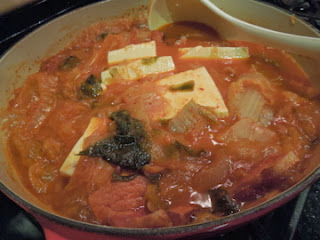Kimchi Chigae: A Spicy Break from Thanksgiving
It’s funny how Thanksgiving makes you run
toward ethnic foods. After several
successive meals of Thanksgiving leftovers (with more turkey in the freezer)
and post-Thanksgiving improvisations (smoked turkey spaetzle soup) we were
ready to leave behind this most American of meals for a while. Especially with Will recovering from a nasty
cold with clogged sinuses, something wickedly spicy and brothy and hearty—and,
most of all, ethnic—appealed to us.
We thought about getting some Thai Tom Yum soup—that will
clear up a lot of congestion!—but we also didn’t want to leave home once we
cocooned ourselves back in our condo.
That’s when I remembered that we had a jar of extra-fermented kimchi. I offered Will either kimchi guk (more
brothy) or kimchi chigae (more stew-y).
Since I had some good pork belly, I decided to go with the stew version
of the Korean classic.
I’m not an expert cook of Korean foods, but the internet has
made it very easy to find ways to make just about anything these days—even
those foods which I didn’t realize had recipes.
My mother would never have put down in exact measurements how to prepare
some traditional dishes like kimchi chigae, but the web yielded pages of sites
with recipes in fraction of a second. Of
course they all varied slightly, and I used a slightly different version from
the one I had used previously. But,
really, we are talking about Korean food which is not an exact science.
Combining features of other recipes—and memories of my
mother’s cooking—here is what I ended up making, and how, in step-by-step photos:
You start with some chopped kimchi (surprise!) and its
juices, add some sliced onion, and sprinkle a little sugar, red pepper flakes
(it’s neither ground nor crushed—easily found in Asian grocery stores), and hot
chili paste (another item from a store like H-Mart). Then you pour enough water to dilute the
mixture a bit and so that you can have some broth. As you can see, it all looks fairly bright.
Will likes this part a lot.
You can add—if you are not a vegetarian, of course—some sliced pork
belly. We happened to have some lightly
smoked pressed cooked bacon, and it was perfect. It wasn’t so smoky that the overall flavor was
impacted (nor is it really easy to alter the unsubtle flavor of stewed kimchi), and the bacon tasted great! In
any case, you bring the mixture to a boil and then turn the heat down to medium
low for about 20-30 minutes until the kimchi is much softer and the color is more like a dull orange (below) as opposed to the bright color it was at the beginning.
At this point, you can slice some medium firm tofu (silky is
too soft, and I usually reserve firm tofu for pan-frying) and let it warm up
for another 5 minutes or so. Some recipes don’t call for
this, but I never miss a chance to add sesame oil, and it’s a nice addition to
both the kimchi chigae and kimchi guk (the soup).
Will went through the dish in no time, inhaling the
spiciness and the heat! He said it was
exactly what his body needed. I have to
agree with him.







Comments
Post a Comment